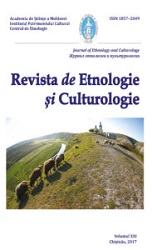The dynamics of the ethnic composition
of the MASSR population in 1926–1939
The dynamics of the ethnic composition
of the MASSR population in 1926–1939
Author(s): Oleg GaluscencoSubject(s): History, Essay|Book Review |Scientific Life
Published by: Institutul Patrimoniului Cultural al Academiei de Științe a Moldovei
Keywords: population; interethnic relations; Moldavian ASSR; Transnistria
Summary/Abstract: The article is devoted to the analysis of the dynamics of the population of the Moldavian Autonomous Soviet Socialist Republic. According to the data of the all Soviet Union censuses, the number of the population of the Autonomous Republic decreased in the interwar period from 572,339 in 1926 to 569,534 people in 1937. In 1939, the number of the population has grown to 599,156 people. The data of the Romanian census of 1941 are given for comparison: the number of the population decreased to 477,885 people. The main reasons of the decreasing number of the population of MASSR in the years 1926–1937 were the famine of 1932–1933 and the mass repressions. As well, an important role was played by the migration of people beyond the borders of the Autonomous Republic to other regions of the USSR. In the period of 1926–1939, the number of Jews was reduced by 11,529 people; Poles – by 1,463; Moldovans – by 1,437, Czechs and Slovaks – by 47. At the same time, there was a rise in the number of Ukrainians – by 26,310, Russians – by 12,410, Bulgarians –by 1,329, Germans – by 1,206, etc. THe article is mostly based on the statistical and archival sources of the interwar period, first of all, the general censuses of 1926, 1937 and 1939. Previously published scientific literature is also used.
Journal: Revista de Etnologie şi Culturologie
- Issue Year: XXI/2017
- Issue No: 1
- Page Range: 111-116
- Page Count: 6
- Language: English

